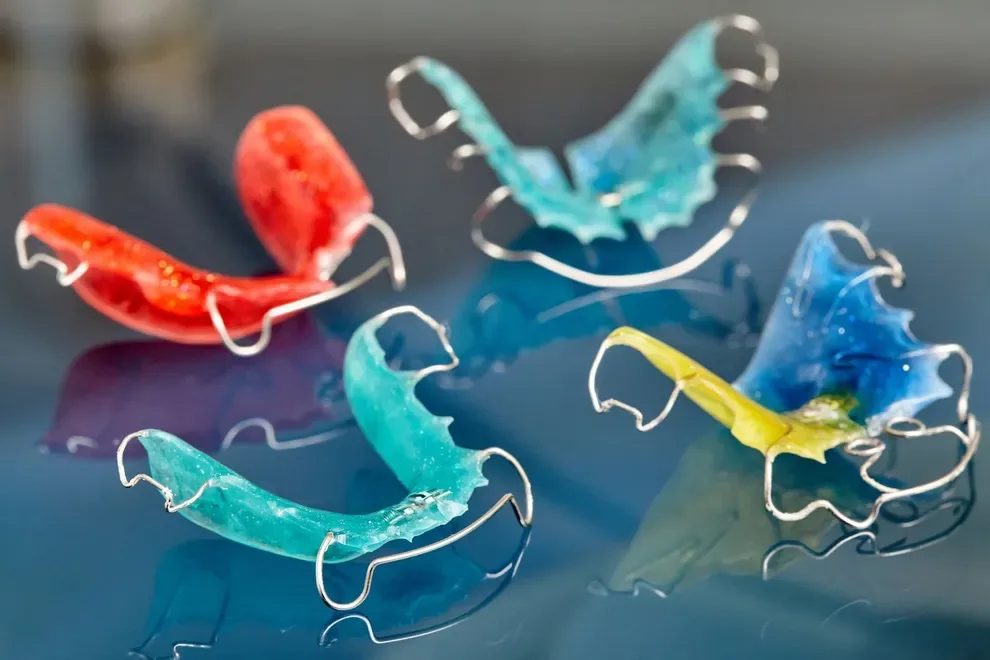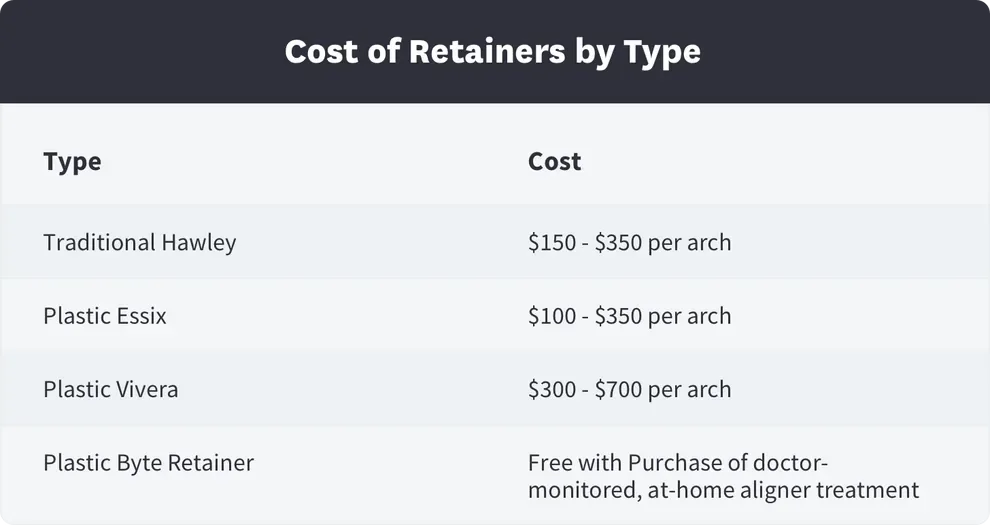How to Avoid Expensive Retainers

Table of Contents
- Why are Retainers so Expensive?
- Why are Permanent Retainers so Expensive?
- Getting the Best Retainer
- Where to Get Cheap Retainers
- Retainer Types Compared
- How To Make Retainers Last Longer
- Insurance Coverage For Retainers
- Retainers After Aligners
You can avoid expensive retainers by choosing a teeth straightening plan that includes your first set of retainers in the overall cost. Then, take good care of your retainers, so you don’t have to pay replacement costs if they are lost or damaged.
Retainers are a valuable part of orthodontic treatment, and they are important whether you get braces or you use clear aligners like Invisalign or Byte. You may wear a retainer for one or two years after you complete braces or aligner treatment, but most often, it’s recommended to wear it nightly for the rest of your life.

Why are Retainers so Expensive?
The relatively high price of retainers provided through an orthodontist may be surprising. However, these devices are custom-made to fit and retain your corrected bite. The price may vary depending on your provider and other factors.
Retainer types compared
The type of retainer you choose will also impact your cost. Here are the most popular types of retainers and their costs:
| Hawley | Permanent | Clear Aligner |
What is it? | A removable device that consists of a plastic piece (which sits on the roof of your mouth) and a wire that encircles your top teeth | A small wire permanently affixed to the back of your lower teeth | Removable plastic trays that enclose your teeth from root to tip |
Approximate initial cost if not bundled into your treatment plan | $200-$500 | $300-$600 | $1,000 |
Required maintenance | High; must be brushed very carefully | Low; can’t be removed for cleaning | Moderate; durable materials make cleaning easy |
Longevity | 1-2 years | 5 or more years | 2-5 years |
Effectiveness | Effective if worn as directed | Very effective, as it can’t be removed | Effective if worn as directed |
Why are Permanent Retainers so Expensive?
Permanent retainers are similar in cost to other retainer options. They usually cost between $150 to $500, depending on your treatment needs and plan. If you get a permanent retainer for both your top and bottom jaws, you may end up spending $1,000 total.
You might also need to visit your dentist more frequently — twice a year instead of just once a year, for example — which can add costs over time.
Permanent retainers will be removed at some point in your life. Although they are not removable, your dentist will determine when treatment with the retainer is no longer necessary, often years later. You will need to pay for the visit to have the retainer removed.
Your dentist will not give you a permanent retainer unless it is the best option to prevent your teeth from shifting out of alignment. If you are an adult, your orthodontic treatment might not be covered by your insurance. Work with your dentist to determine the best options for your mouth and your wallet.
How can you make your retainers last longer?
Caring for your retainer is one of the best ways to reduce your overall costs. If you don’t break or lose it, you won’t have to purchase a new one.
If you have a removable retainer like a Hawley or an aligner tray, keep your case with you. When you take out the appliance to eat and drink, place it safely within your case. That way, you won’t be likely to throw it away or leave it behind.
Keep cleansing materials (such as a soft-bristled brush and non-abrasive toothpaste) with you, and brush your appliance before you put it back in your mouth. Use those same tools to clean the appliance when you wake up and when you head to bed at night.
Remember that very abrasive cleansers (like charcoal toothpaste) can roughen or ruin your removable appliances, as can very hot water. Clean only with the tools your dental professional recommends.
If you have a permanent retainer, resist the impulse to push it or scrape it with your tongue, and don’t dig at the dental glue with your toothbrush. By leaving your appliance alone, you’ll be less likely to break it or detach it from your teeth.
Insurance coverage for retainers
Can you use your dental insurance plan as you learn how to avoid expensive retainers? It depends. Some dental insurance plans provide robust coverage for orthodontic care (including retainers), but others do not.
For example, MetLife plans typically cover orthodontic services for people 19 and younger. Adults who need new orthodontic care or to replace older retainers may need to cover those costs out of pocket.
However, Delta Dental plans with orthodontic coverage will pay for one set of retainers during a customer’s lifetime. If you have a plan like this, you could get the first set of retainers for free. But if you break that set, you’ll pay for the rest out of pocket.
To determine if your dental insurance plan covers retainers, read the policy and look for a section about “orthodontic care.” Look for terms like “excluded” or “limited” to determine if the plan isn’t likely to help. If you have any questions about your coverage, call the member services number on your insurance card and ask a representative for help.
Dental plans that cover orthodontics and aligners may have higher premiums than those that do not. However, if you know you’ll need this care and are likely to need retainers, the added expense could be more than worthwhile.
Retainers After Aligners
Doctor-monitored, at-home aligners help people achieve straight teeth and beautiful smiles without continual visits to an orthodontist. It’s a course of teeth straightening that takes place at home, where you replace your teeth aligners every couple weeks. The process is often faster and cheaper than straightening teeth with braces, and it works well for minor to moderate teeth misalignment issues.
You may wonder if you even need a retainer if you use aligners to straighten your teeth. Can you keep your last plastic aligner and wear it as needed? You may assume this works similarly to a retainer, but you should not stick to this aligner without consulting with your treatment team.
Again, the retainers provided after a course of aligners are thicker and more durable than a standard aligner.
Getting the Best Retainer without Breaking the Bank
If you need a retainer following braces, your orthodontist will create the device for you. These devices are custom made for your teeth.
If you lose or break your retainer, you’ll need a new one, so it’s important to take care of your retainer. It is equally important to wear a retainer to keep your teeth aligned for years.
If you skip this treatment to save a few hundred dollars, your teeth will most likely return to their original positioning fairly quickly. This wastes all the money you spent on straightening your teeth.
There are some ways to avoid spending hundreds of dollars on a retainer, especially if you work with mail-order aligner companies like Byte.
Where Can You Get Cheap Retainers?
If you’re considering orthodontic treatment options, and factoring in the overall price of treatment as well as the cost of retainers, you’ll likely come to the conclusion that at-home clear aligners offer more value than braces treatment.
Straightforward, affordable pricing is one of the reasons mail-order aligners have become so popular with those looking to correct mild-to-moderate orthodontic issues. Aligners offer many other advantages over braces as well. They’re removable, virtually invisible, and offer fast results. The average treatment time is about 4 to 6 months.
Top aligner providers offer even more. Byte, for example, includes a HyperByte massage device (massage tools like these have been shown to improve aligner comfort and effectiveness) in every aligner kit, plus a Byte for Life guarantee and access to their award-winning app where you can track your aligner progress throughout your doctor-monitored treatment.
Byte also includes your first after-treatment retainer for free.
